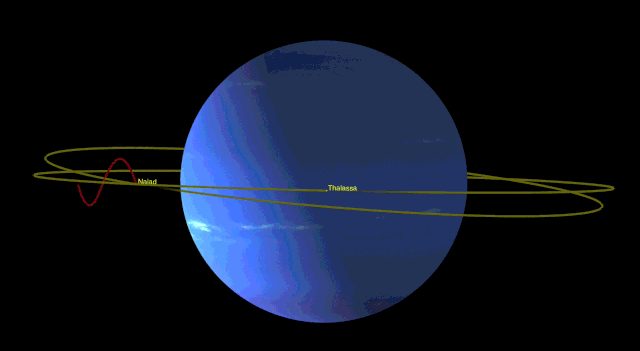Space Ballet: 2 Neptune Moons Perform an Unusual Orbital Dance
Neptune's two innermost moons are locked in an unusual "dance of avoidance," with their perfect choreography ensuring the moons never get too close to each other.
That's a tricky feat, since their orbital paths are separated by just 1,150 miles (1,850 kilometers). But the moons themselves never come closer than within 2,200 miles (3,450 kilometers) — a few hundred miles shorter than the width of the U.S.
If an observer looks at the moons' orbits edge-on, they would see the moon Naiad dip above and below its neighbor Thalassa because of its slightly tilted orbit. In addition, their dances align so that for every 69 orbits of Thalassa, Naiad orbits 73 times. Then, their choreography begins again from the beginning.
Related: Photos of Neptune, The Mysterious Blue Planet
"We refer to this repeating pattern as a resonance," lead author Marina Brozovic, a solar system dynamicist at NASA's Jet Propulsion Laboratory in California, said in a statement. "There are many different types of 'dances' that planets, moons and asteroids can follow, but this one has never been seen before."

Resonances are common among moons of the giant planets, but typically, these relationships are simpler than the one between Thalassa and Naiad. Jupiter, Saturn, Uranus and Neptune collectively have dozens of these worlds to interact. Some of these moons formed with the planets, while some are former asteroids captured by the immense gravity of these planets.
Neptune has 14 confirmed moons. Naiad and Thalassa are both on the small side, each only 60 miles (100 km) long. Studies suggest that Neptune's moon system had a big change when it captured the giant moon Triton, which caused a lot of chaos (and debris from moon collisions) that eventually coalesced into newer moons and rings.
Get the Space.com Newsletter
Breaking space news, the latest updates on rocket launches, skywatching events and more!
"We suspect that Naiad was kicked into its tilted orbit by an earlier interaction with one of Neptune's other inner moons," Brozovic said. "Only later, after its orbital tilt was established, could Naiad settle into this unusual resonance with Thalassa."
Astronomers studied the dance using the Hubble Space Telescope. The moons' motions are not only interesting to look at, but also provide information about the interior composition of Neptune's inner moons, the team said. Their orbital motions let astronomers compute the mass of these moons, which appear to have densities close to that of water ice.
The research was published Wednesday (Nov. 13) in the journal Icarus, and is also available in the preprint format on arXiv.org.
- Birth of 'Great Dark Spot' Storm on Neptune Seen for 1st Time (Photo)
- Neptune Shines in New Photos Marking First Orbit Since Its Discovery
- Neptune's 'Lost' Moon Spotted for 1st Time In 20 Years (Photos)
Follow Elizabeth Howell on Twitter @howellspace. Follow us on Twitter @Spacedotcom and on Facebook.

Join our Space Forums to keep talking space on the latest missions, night sky and more! And if you have a news tip, correction or comment, let us know at: community@space.com.

Elizabeth Howell (she/her), Ph.D., is a staff writer in the spaceflight channel since 2022 covering diversity, education and gaming as well. She was contributing writer for Space.com for 10 years before joining full-time. Elizabeth's reporting includes multiple exclusives with the White House and Office of the Vice-President of the United States, an exclusive conversation with aspiring space tourist (and NSYNC bassist) Lance Bass, speaking several times with the International Space Station, witnessing five human spaceflight launches on two continents, flying parabolic, working inside a spacesuit, and participating in a simulated Mars mission. Her latest book, "Why Am I Taller?", is co-written with astronaut Dave Williams. Elizabeth holds a Ph.D. and M.Sc. in Space Studies from the University of North Dakota, a Bachelor of Journalism from Canada's Carleton University and a Bachelor of History from Canada's Athabasca University. Elizabeth is also a post-secondary instructor in communications and science at several institutions since 2015; her experience includes developing and teaching an astronomy course at Canada's Algonquin College (with Indigenous content as well) to more than 1,000 students since 2020. Elizabeth first got interested in space after watching the movie Apollo 13 in 1996, and still wants to be an astronaut someday. Mastodon: https://qoto.org/@howellspace
-
rod After reading the report and cited reference, it seems that the long term stability of this orbital configuration - may not show it can remain stable over some 4.5 billion years or more, NASA Finds Neptune Moons... There are various reports too on the age of Saturn ring system too indicated issues with long age and long time stability. Triton retrograde orbit is always interesting topic.Reply
